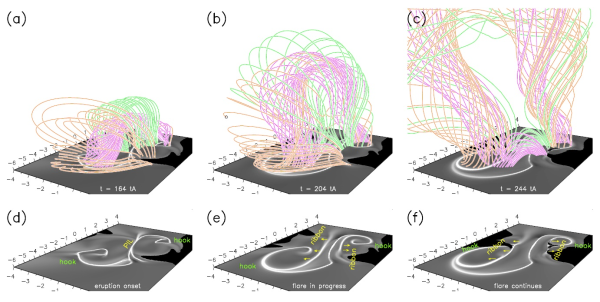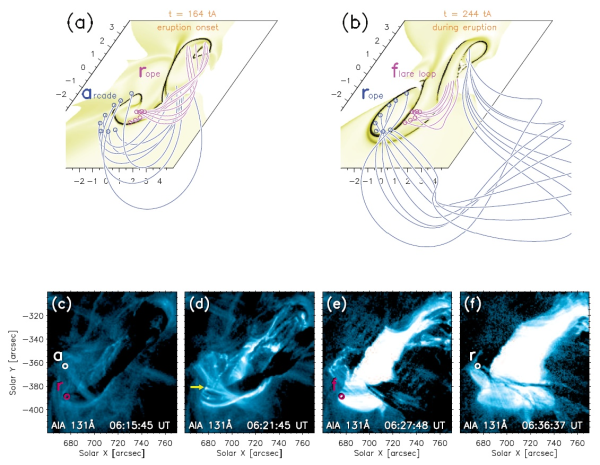The Aulanier Effect: drifting footpoints of CME flux ropes
| Nugget | |
|---|---|
| Number: | 501 |
| 1st Author: | Jaroslav DUDÍK, |
| 2nd Author: | Juraj LÖRINČÍK and Brigitte SCHMIEDER |
| Published: | July 21, 2025 |
| Next Nugget: | Synchrotron emission from shocks |
| Previous Nugget: | Five Hundred Nuggets |
Introduction
Solar flares and eruptions are powered by magnetic reconnection, a process for rearranging the magnetic fields to a lower energy state. A flare's bright chromospheric ribbons map the photospheric footpoints of the reconnecting fields. Eruptive solar flares, characterized by an unstable magnetic flux rope that can drive a coronal mass ejection (CME), often exhibit a pair of J-shaped ribbons. While the straight parts of these ribbons are parallel to the polarity inversion line (the PIL, which is the locus of zero vertical field, and often a structure with large-scale patterns in the photosphere), the curved ribbon "hooks" encircle the footpoints of the erupting magnetic flux rope [Ref. 1], as shown in Figure 1. Outside of this J-shaped ribbon is the connectivity domain of inclined coronal arcades (loops) that surround the legs of the erupting flux rope, as well as the arcades overlying the flux rope. These arcades are shown in orange and green in Figure 1, respectively.

Evolution of the flare ribbon hook
The flare reconnection leads to the well-known separation of the straight parts of the ribbons. This means that a portion of the original footpoints of the flux rope, located within the hooks, reconnect to become ("turn to") the flare loops as they are swept by the straight parts of the ribbon (c.f., orange and pink field lines in panels (a)-(c)). MHD modelling (Ref. [1]) showed that in addition to this, the hooks of the ribbons first expand outwards, sweeping footpoints of coronal loops surrounding the footpoints of the erupting flux rope. These loops in turn reconnect to become part of the erupting flux rope (orange twisted field lines in panel (c) of Figure 1).
Drifting of the erupting flux-rope's footpoints
The expansion of the ribbon hook is at later stages followed by its shrinking and motion outward from the PIL. This evolution of the ribbon hook, along with the separating motions of the straight parts of the ribbons, mean that the area of the footpoints of the erupting flux rope (contained within the hook) is drifting continuously. Essentially, the erupting flux rope is eroded on the inside by the straight parts of the ribbons, with the inner parts of the flux rope turning into flare loops. Meanwhile, the flux rope is built from the outside, as coronal loops reconnect into the flux rope.
Note that the magnetic reconnection described here (which we term ar-rf, for "arcade-to-rope") is definitively a 3D process that is not a part of the long-standard CSHKP 2D picture.
Observational evidence
Observational evidence for the drifting of the erupting flux rope footpoints has been seen in numerous eruptive flares. Of those, in Ref.[2] we identified all four constituents of the arcade-to-rope (ar-rf) reconnection geometry, see Figure 2: In the famous filament eruption of SOL2011-06-07, the footpoint of the field line originally composing the erupting flux rope (filament) r turns to a footpoint of a flare loop f, while the original footpoint of a coronal arcade a turns into a new flux rope footpoint r. Recently, a spectrum of a filament reconnecting with coronal loops have been acquired by IRIS (see Figure 3), showing strong blueshifts in the Si IV line (of the order of 200 kms/) as well as large non-thermal widths (Ref. [3]).


Implications for space weather
The outward drift of the flux rope/CME footpoints means that the total magnetic flux contained within the erupting flux rope changes during the eruption. Typically, an initial fast increase of flux is observed, of about 40-120%, followed by a milder decrease, of the order 20-30%, depending on the eruption. In one case, the flux within the erupting flux rope has been observed to be entirely replaced (Ref. [4]), meaning that the erupting flux rope was completely rebuilt during its eruption. In another case, the drifting of the CME footpoints, observed as coronal dimmings, was ongoing for many hours, until they finally merged with a neighbouring coronal hole. In addition to that, data-driven MHD modelling has confirmed that the CME flux ropes can fragment into several sub-ropes as a result of the ar-rf reconnections.
Due to the obvious consequences of the drifting of the flux rope footpoints for the evolution of CMEs and therefore for space weather, we propose to name this phenomenon the "Aulanier Effect." This is in honor of our colleague, Dr. Guillaume Aulanier, who first identified the CME footpoint drift based on his own MHD modelling, before numerous observational analyses validated the model predictions.
References
[1] "Drifting of the line-tied footpoints of CME flux-ropes"
[4] "Complete replacement of magnetic flux in a flux rope during a coronal mass ejection"